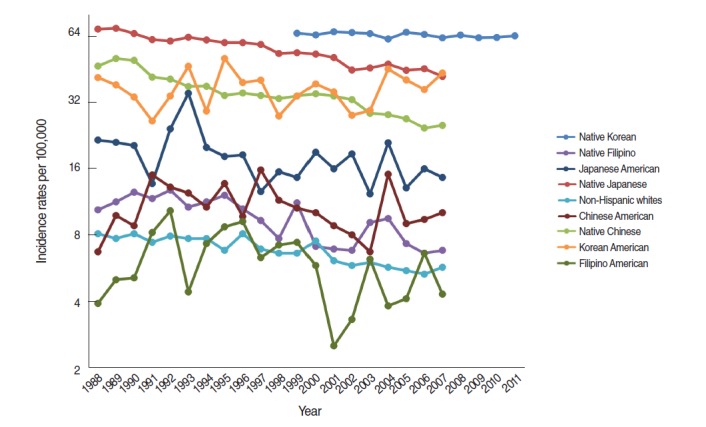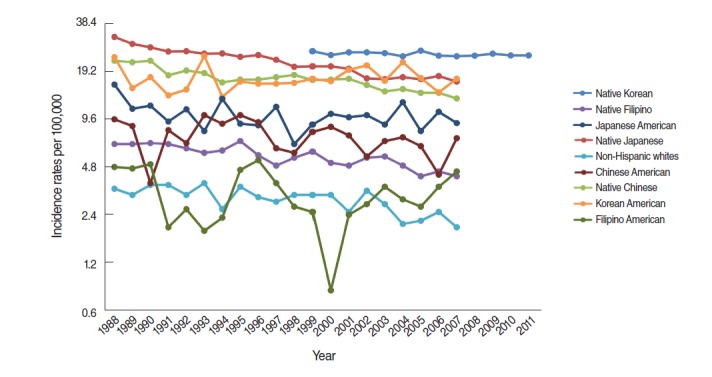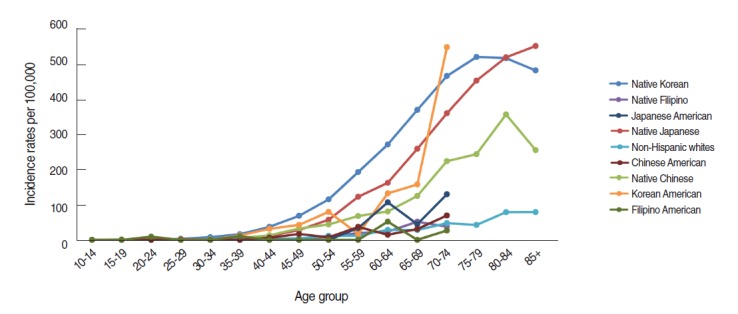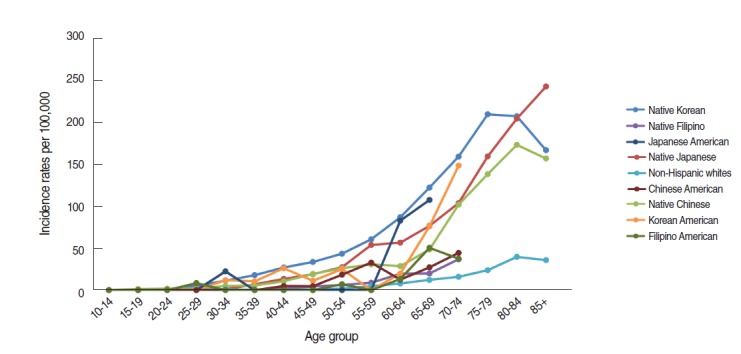Abstract
Stomach cancer is the second most common cancer in Eastern Asia, accounting for approximately 50% of all new cases of stomach cancer worldwide. Our objective was to compare the stomach cancer incidence rates of Asian Americans in Los Angeles with those of native Asians to assess the etiology of stomach cancer from 1988 to 2011. To examine these differences, Asian Americans (Korean, Japanese, Chinese, and Filipino Americans living in Los Angeles, California, USA) and native Asians (from Korea, Japan, China, and the Philippines) were selected for this study. Using the Cancer Incidence in Five Continents database, stomach cancer incidence rates were examined. Data from the National Cancer Registry of Korea were used for native Koreans. Between native countries, the incidence rates in Japan, China, the Philippines, and the US declined over time, but the incidence in Korea has remained constant. The incidences among Asian immigrants were lower than those among native Asians. The incidence rates of males were approximately 2 times higher than those among females in Asian countries were. The effect of immigration on stomach cancer incidence suggests that lifestyle factors are a significant determinant of stomach cancer risk. However, the incidence in Korea remains the highest of these countries
Keywords: Asian Americans, Stomach neoplasms, Incidence, Immigrants
INTRODUCTION
Stomach cancer is the fifth most common cancer in the world and approximately one million new cases were reported in 2012 [1]. The current global trend of stomach cancer incidence has shown a substantial decline since 1975, when stomach cancer was the world’s most common cancer [2]. Although stomach cancer incidence rates have declined in East Asian countries following the global trend, stomach cancer is still the second most common cancer in East Asia, accounting for approximately 50% of all cases of stomach cancer worldwide [3]. Among the East Asian countries, the Republic of Korea (hereafter Korea) has the highest incidence of stomach cancer in the world, and the incidence of stomach cancer in China accounts for more than 40% of all new cases [1,4,5]. Likewise, high stomach cancer incidence remains a major public health problem in Japan despite efforts to create early detection screening programs [3]. In contrast, the US has one of the lowest incidence rates of stomach cancer; stomach cancer is not one of the top 15 most common cancers [4,5]. Based on recent reports, the stomach cancer incidence rate in Korea was 11.7 times higher than that in the US [4,5].
The US is a heterogeneous country with many immigrants, and approximately 14.7 million Americans are Asian American, representing 4.8% of the total US population in 2010 [6]. The state of California has the largest Asian population of any of the US states. Many Asian Americans live in Los Angeles, California. In particular, Chinese Americans comprise most of the Asian population in California (4.2% of the total population) followed by Filipino, Korean, and Japanese people [7]. Owing to this racially diverse population, the state of California makes special efforts to collect data on the cancer incidence rates of each specific ethnic group. These data exist specifically for those living in Los Angeles.
Since stomach cancer incidence in the US is significantly lower than that in Asia, comparing the cancer incidence rates of Asian Americans living in Los Angeles with those among native Asians in their own respective countries might provide an important clue into the etiology of the disease. The Asian countries with a high-risk of stomach cancer, specifically Korea, Japan, China, and the Philippines, were selected due to their geographical proximity and cultural similarities. Non-Hispanic whites in Los Angeles were included as the reference group.
Several studies have reported risk factors of stomach cancer, and some of the established risk factors include Helicobacter pylori infection, smoking, and diet [3]. Among these three risk factors, diet habits change most dramatically among those who move from an Asian country to a Western country, a phenomenon referred to as “dietary acculturation” [8]. Numerous studies have indicated the negative impacts of dietary acculturation such as obesity and diabetes [9,10]. However, in the present study, we hypothesized that diet acculturation among Asian Americans might have a positive impact on stomach cancer incidence and that those immigrants may benefit from assimilating Westernized foods into their diet, which might then contain fewer traditional Asian foods that tend to be salted and/or pickled. Thus, the objective of the present study was to compare the incidences of stomach cancer among Asian immigrants living in Los Angeles, California with those among native Asians by sex and age group. A comparative study evaluating countries with high and low incidences is necessary because it could provide valuable insight into the etiology and possible preventive methods that should be promoted to reduce stomach cancer incidence rates and ease the related public health burden.
MATERIALS AND METHODS
Cancer Incidence in Five Continents (CI5) is an international cancer incidence report generated by the International Agency for Research on Cancer and the International Association of Cancer Registries. The International Classification of Disease (ICD, 10th revision) code for stomach cancer, C16, was used. The CI5plus database provides race-specific, age-specific, sex-specific, and cancer site-specific estimates for 118 selected populations. The data source for Asian ethnic groups in the US was only available from the state of California for the city of Los Angeles. The composition of Asian populations in Los Angeles included 4.2% Chinese, 3.3% Filipino, 2.2% Korean, and 1.0% of Japanese people [7]. The age-standardized rates per 100,000 individuals in the world population were used [11]. In addition, the rate per 100,000 individuals was used to compare the annual incidence rates of stomach cancer by 5-year interval age groups starting from 10 years of age.
The stomach cancer incidence rates for native Asian countries were also collected from the CI5 dataset to allow for reliable data comparisons. Since the CI5 did not have data on entire countries, the data available from specific regions of each country were used to compare native Asian groups. The well-known cities of each country were selected: Osaka for Japan, Shanghai for China, and Manila for the Philippines. However, data from Statistics Korea were used for the data analysis on native Koreans because no such data were available in the CI5. Since the data from Korea were standardized based on the entire Korean population, the direct standardization method was used to convert these data into a Segi world population dataset for consistency. The stomach cancer incidence data from 1988 to 2011 were used.
RESULTS
Comparison of annual stomach cancer incidence rates by sex and race
For males, the overall age-standardized cancer incidence rate for native Koreans (average 65.4 per 100,000) was the highest among all of the races; however, this rate was the lowest among Filipino Americans (average 5.9 per 100,000) (Figure 1) [11, 12].
Figure 1.

The male age-standardized stomach cancer incidence rates (per 100,000) of non-Hispanic whites, Asian-Americans in Los Angeles, US, and Asian countries by year, 1988- 2007 [11,12].
Among the native groups, the incidence demonstrated a decreasing trend in Japanese, Chinese, Filipino, and non-Hispanic white males, whereas the incidence was constant in Korean males. For all US immigrant ethnic populations, the overall stomach cancer incidence rates were lower than those among the native groups. The incidence rate of Korean American males was one-third less than the incidence rates of native Korean males. The incidence rate of Japanese American males and Filipino American males was two-thirds less than the incidence rates of native Japanese males and native Filipinos males. The incidence rate of Chinese American males was three-quarters less than the incidence rates of native Chinese males. Among Asian male immigrants, the incidence rates for Korean Americans, Chinese Americans, and Filipino Americans remained constant, but the incidence rate of Japanese Americans tended to decrease over time.
Among all females, the overall age-standardized cancer incidence rate among native Koreans (average 24.7 per 100,000) was the highest, but Filipino Americans had the lowest incidence rate (average 2.7 per 100,000). Among the native groups, the incidence rates of Japanese, Chinese, Filipino, and non-Hispanicwhite females tended to decrease over time, yet the incidence rate among Korean females remained constant. For all ethnicities, the overall stomach cancer incidence rates of female immigrants were lower than those among the female native groups. The incidence rate of Korean American females was two-thirds less than the incidence rates of native Korean females. The incidence rate of Japanese American and Chinese American females was one-half lower than the incidence rates of native Japanese and native Chinese females. The incidence rate of Filipino American females was one-third less than the incidence rates of native Filipino females. Among the Asian female immigrant groups, the incidence rate among Korean American, Japanese American, and Filipino American females remained constant, while the incidence rate among Chinese American females decreased (Figure 2) [11,12].
Figure 2.

The female age-standardized stomach cancer incidence rates (per 100,000) of non-Hispanic whites, Asian-Americans in Los Angeles, US, and Asian countries by year, 1988- 2007 [11,12].
Between males and females, there was a great disparity in the overall incidence rates of stomach cancer. The incidence rates of males were significantly higher than those for females across all groups. The highest disparity was found between the incidence rates of native Korean males and females; native Korean males had a 2.6 times higher incidence than their female counterparts did.
Comparison of annual stomach cancer incidence rates by age group and race
For both males and females in all age groups, the incidence of stomach cancer increased with age. Among all native Koreans, native Japanese, native Chinese, Korean Americans, and Japanese Americans, the incidence rates of stomach cancer increased steeply with age. Among the different racial groups in Los Angeles, the incidence of stomach cancer among Korean Americans demonstrated the steepest increase, which is expected based on the rate of stomach cancer among native Koreans. Native Filipinos had the lowest incidence of stomach cancer. From age 70 and older, the incidence tended to decrease for all groups, except for all age groups in the native Japanese population where the incidence rates continued to increase (Figures 3 and 4) [11,12].
Figure 3.

The age-standardized stomach cancer incidence rates for males by age group of non-Hispanic whites, Asian-Americans in Los Angeles, US, and Asian countries in 2007 (World, per 100,000) [11,12].
Figure 4.

The age-standardized stomach cancer incidence rates for females by age group of non-Hispanic whites, Asian-Americans in Los Angeles, US, and Asian countries in 2007 (World, per 100,000) [11,12].
DISCUSSION
A steady decline in stomach cancer incidence has been observed worldwide over the last several decades even in historically high-risk countries such as Japan and China [13]. In the US, the incidence has decreased by more than 80% [14]. Likewise, the same decreasing trends were observed in the present study except for native Koreans. The incidence tended to be lower among Asian populations in the US where the overall incidence rate of stomach cancer is also low. These data suggest that environmental factors play a role in the development of stomach cancer. The factors that are known to have accounted for this decline include antibiotics against H. pylori, early detection programs, improved medical treatments, and changes in dietary habits by consuming more fresh vegetables and fruits rather than the traditional pickled and salty foods [15]. Nevertheless, no change in the incidence of stomach cancer in Korea was found; therefore, further study is needed.
In addition, the incidence rates among males were significantly higher than those among females for all groups. Unfortunately, a detailed analysis and explanation of sex-related differences are not available in the literature; instead, only vague theories that assume behavioral differences especially among males such as tobacco smoking have been speculated to explain the etiology behind this unchanging, high incidence of stomach cancer. One interesting study conducted by researchers at the Massachusetts Institute of Technology reported that estrogen might protect females from developing stomach cancer [16]. Furthermore, the results of the present study indicate that the incidence of stomach cancer tends to increase with age, but peak at age 70. One study found that the incidence tends to rise progressively with age, and the highest incidence occurs between 50 and 70 years [9]. However, in the present study, this trend decreased for most groups aged 80 and older, which might have resulted from a selective survival bias and the low reliability of the incidence data on older adults.
The overall stomach cancer incidence rate for native Koreans was the highest among all groups for both males and females, whereas both non-Hispanic whites and Filipino Americans showed the lowest rate. Interestingly, the pattern of incidence rates within Asian American ethnic groups resembled the pattern of incidence rates in their native countries. Several studies have demonstrated that cancer incidence rates among immigrants follow a similar direction to those in their respective countries of origin [17]. One study that examined the incidence of stomach cancer among Asian American immigrants from 1973 to 1986 reported that the incidence among Chinese immigrants was similar to that among whites [13]. Another study investigated the effect of diet and place of birth on stomach cancer incidence and demonstrated that second generation Hawaiian Japanese people had lower stomach cancer incidence than first generation Hawaiian Japanese people did [18]. Therefore, lifestyle might have a significant impact on stomach cancer incidence.
In general, smoking, dietary patterns, and having a H. pylori infection have been considered major risk factors for stomach cancer. The differences in the prevalence of smoking seem to reflect the geographical variations between the incidence rates of stomach cancer in the US and Asia. The prevalence of smoking is lower in the US than that in Asian countries is; the overall smoking prevalence in the US was 17.8%, while that in China, the Philippines, Korea, and Japan was 28.1, 28, 25.8, and 19.7%, respectively [19-23]. This trend in smoking is also reflected in the incidence rate of stomach cancer, as the US had the lowest stomach cancer incidence among the five countries in the present study. Therefore, the variability in tobacco use between the residents of these countries might explain the association between smoking prevalence and stomach cancer incidence. Furthermore, the prevalence of smoking might explain the large difference between the stomach cancer incidences of males and females. The prevalence of smoking in the US was 20.5% for males and 15.3% for females [22]. However, the difference between the prevalence of smoking among males and females was higher in Asian countries compared to the prevalence in the US. For example, the prevalence of smoking was estimated to be 43.7% for males and 7.9% for females in Korea [19]. Therefore, smoking is related to stomach cancer incidence and varies by country and gender.
Regarding dietary patterns, traditional Asian meals tend to have a high salt content and contain preserved foods including soups; therefore, Asians tend to consume a high-salt diet. In addition, the geographical variations of stomach cancer incidence might also reflect differences in the prevalence of H. pylori infections, which are considered to cause more than 50% of all gastric cancer cases worldwide [15]. The prevalence of H. pylori infection exceeds 50% among the general population in Korea, Japan, and China [24]. Interestingly, the incidence of stomach cancer in the Philippines was the lowest among all of the Asian countries, despite their tendency to consume a high-salt diet and the high prevalence of H. pylori infections in the Philippines. Further investigations are needed to examine the etiology of stomach cancer in the Philippines.
There were several limitations in the present study. First, the incidence of stomach cancer calculated for Korean, Japanese, Chinese, and Filipino Americans was possibly less accurate than that calculated for the native populations because some data were missing over several study years in the American dataset. This might have been because a limited number of Asian Americans reside in Los Angeles and because these ethnic groups were surveyed within a specific geographic area. In addition, different immigration patterns over the data collection period might have resulted in missing data. Second, the high incidence observed in Korea and Japan may reflect good practice provided by screening programs and a high level of accessibility to relevant early detection services. These factors could have led to the underestimation of the actual incidence rates in China, the Philippines, and the US. Finally, the data obtained from the CI5 might have misclassified some individuals based on their race. For example, Vietnamese people could have classified themselves as Chinese, and persons of mixed race were likely asked to choose only one racial background in the original survey. Third, the length of residence in California could have distorted the results of this study. Fourth, these findings might not be generalizable to other populations since we only analyzed data on Asian Americans living in Los Angeles. Last, the data on the incidence of stomach cancer in native Koreans were only available from 1999.
In summary, this study compared the incidence rates of stomach cancer between Asian immigrants and native Asians. The migratory effect on stomach cancer incidence suggests that lifestyle plays an important role in the development of stomach cancer. It is expected that increased overall socioeconomic status as well as improved hygienic conditions could have accelerated the decreasing trend we observed in the stomach cancer incidence among immigrants to the US. Moreover, an increased availability of fresh vegetables and fruits could have modified these immigrants’ dietary habits. It is important to note that Korea has had the highest incidence of stomach cancer since 1999 and continues to today, while the incidence in neighboring Asian countries has demonstrated a decreasing trend. This implies that efforts should be made to reduce the incidence of stomach cancer in Korea by looking to other countries that have lowered their national incidence of stomach cancer.
Footnotes
The author has no conflicts of interest to declare for this study.
REFERENCES
- 1.Ferro A, Peleteiro B, Malvezzi M, Bosetti C, Bertuccio P, Levi F, et al. Worldwide trends in gastric cancer mortality (1980-2011), with predictions to 2015, and incidence by subtype. Eur J Cancer. 2014;50:1330–1344. doi: 10.1016/j.ejca.2014.01.029. [DOI] [PubMed] [Google Scholar]
- 2.Cancer Research UK Worldwide cancer incidence statistics: trends over time. [cited 2015 Feb 25]. Available from: http://www.cancerresearchuk.org/cancer-info/cancerstats/world/incidence/
- 3.McCracken M, Olsen M, Chen MS, Jr, Jemal A, Thun M, Cokkinides V, et al. Cancer incidence, mortality, and associated risk factors among Asian Americans of Chinese, Filipino, Vietnamese, Korean, and Japanese ethnicities. CA Cancer J Clin. 2007;57:190–205. doi: 10.3322/canjclin.57.4.190. [DOI] [PubMed] [Google Scholar]
- 4.Ferlay J, Soerjomataram I, Dikshit R, Eser S, Mathers C, Rebelo M, et al. Cancer incidence and mortality worldwide: sources, methods and major patterns in GLOBOCAN 2012. Int J Cancer. 2015;136:E359–E386. doi: 10.1002/ijc.29210. [DOI] [PubMed] [Google Scholar]
- 5.Bray F, Ren JS, Masuyer E, Ferlay J. Global estimates of cancer prevalence for 27 sites in the adult population in 2008. Int J Cancer. 2013;132:1133–1145. doi: 10.1002/ijc.27711. [DOI] [PubMed] [Google Scholar]
- 6.Centers for Disease Control and Prevention Asian American populations. [cited 2015 Feb 25]. Available from: http://www.cdc.gov/minorityhealth/populations/REMP/asian.html.
- 7.United States Census Bureau 2009-2013 American Community Survey 5-year estimates. [cited 2014 October 19]. Available from: http://factfinder.census.gov/faces/tableservices/jsf/pages/productview.xhtml?src=bkmk.
- 8.Jasti S, Lee CH, Doak C. Gender, acculturation, food patterns, and overweight in Korean immigrants. Am J Health Behav. 2011;35:734–745. [PubMed] [Google Scholar]
- 9.Crew KD, Neugut AI. Epidemiology of gastric cancer. World J Gastroenterol. 2006;12:354–362. doi: 10.3748/wjg.v12.i3.354. [DOI] [PMC free article] [PubMed] [Google Scholar]
- 10.Unger JB, Reynolds K, Shakib S, Spruijt-Metz D, Sun P, Johnson CA. Acculturation, physical activity, and fast-food consumption among Asian-American and Hispanic adolescents. J Community Health. 2004;29:467–481. doi: 10.1007/s10900-004-3395-3. [DOI] [PubMed] [Google Scholar]
- 11.International Agency for Research on Cancer CI5: cancer incidence in five continents. [cited 2015 February 25]. Available from: http://ci5.iarc.fr/Default.aspx.
- 12.Korean Statistical Information Service Stomach cancer prevalence. [cited 2015 February 25]. Available from: http://kosis.kr/statHtml/statHtml.do?orgId=117&tblId=DT_117N_A00022&conn_path=I3 (Korean, author’s translation)
- 13.Kamineni A, Williams MA, Schwartz SM, Cook LS, Weiss NS. The incidence of gastric carcinoma in Asian migrants to the United States and their descendants. Cancer Causes Control. 1999;10:77–83. doi: 10.1023/a:1008849014992. [DOI] [PubMed] [Google Scholar]
- 14.Jemal A, Center MM, DeSantis C, Ward EM. Global patterns of cancer incidence and mortality rates and trends. Cancer Epidemiol Biomarkers Prev. 2010;19:1893–1907. doi: 10.1158/1055-9965.EPI-10-0437. [DOI] [PubMed] [Google Scholar]
- 15.American Cancer Society Cancer facts & figures 2008. [cited 2014 Oct 19]. Available from: http://www.cancer.org/acs/groups/content/@nho/documents/document/2008cafffinalsecuredpdf.pdf.
- 16.Trafton A. A. Study explains why men are at higher risk for stomach cancer. [cited 2014 Oct 19]. Available from: http://newsoffice.mit.edu/2011/gastric-cancer-0713.
- 17.Lee J, Demissie K, Lu SE, Rhoads GG. Cancer incidence among Korean-American immigrants in the United States and native Koreans in South Korea. Cancer Control. 2007;14:78–85. doi: 10.1177/107327480701400111. [DOI] [PubMed] [Google Scholar]
- 18.Kolonel LN, Nomura AM, Hirohata T, Hankin JH, Hinds MW. Association of diet and place of birth with stomach cancer incidence in Hawaii Japanese and Caucasians. Am J Clin Nutr. 1981;34:2478–2485. doi: 10.1093/ajcn/34.11.2478. [DOI] [PubMed] [Google Scholar]
- 19.No Smoke Guide Adult smoking rate. [cited 2014 Oct 19]. Available from: http://www.nosmokeguide.or.kr/mbs/nosmokeguide/subview.jsp?id=nosmokeguide_010101000000 (Korean, author’s translation)
- 20.Japan Tobacco Inc JT’s annual survey finds 19.7 percent of Japanese adults are smokers. 2014. [cited 2014 October 19]. Available from: http://www.jt.com/media/press_releases/2014/0730_01.html.
- 21.World Health Organization 2009 Philippines’ global adult tobacco survey. 2010. [cited 2014 Oct 19]. Available from: http://www.who.int/tobacco/surveillance/2009_gats_report_philippines.pdf?ua=1.
- 22.Centers for Disease Control and Prevention [cited 2015 Apr 19]. Available from: http://www.cdc.gov/tobacco/data_statistics/fact_sheets/adult_data/cig_smoking/
- 23.WHO Western Pacific Region Tobacco in China. [cited 2014 Oct 19]. Available from: http://www.wpro.who.int/china/mediacentre/factsheets/tobacco/en/
- 24.Salih BA. Helicobacter pylori infection in developing countries: the burden for how long? Saudi J Gastroenterol. 2009;15:201–207. doi: 10.4103/1319-3767.54743. [DOI] [PMC free article] [PubMed] [Google Scholar]


